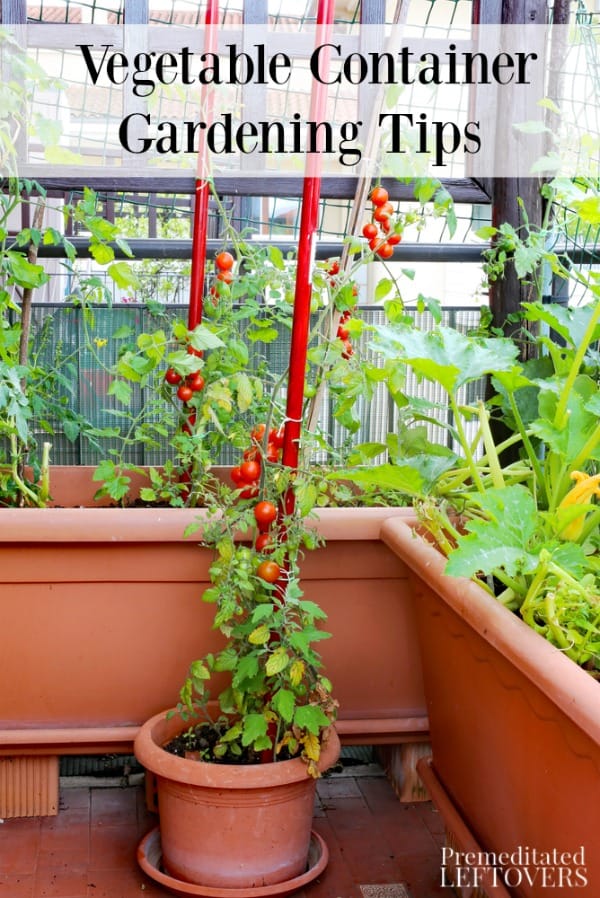These tips on vegetable container gardening include container sizes and planting recommendations for common vegetables.

Almost all vegetables can be grown in containers and vegetable container gardening can yield a ton of veggies to boot! One of the best parts of vegetable container gardening is that if a plant isn’t doing so hot in a particular space, you can move it! The hardest part about container gardening is picking out which plants you want to grow and the size of the container to put them in.
Vegetable Container Gardening
There are a few key things to remember when picking out containers for your vegetable garden. If you live in a very hot climate, make sure to choose hard plastic over soft as the heat transfers quickly to the plant’s roots and can fry them. It is best to use thick plastic, Styrofoam, terracotta or ceramic containers if you are battling extreme heat. Same thing if you are gardening on a rooftop or balcony – you will want to stick with materials that are lighter rather than something heavy like a big clay pot.
Before you pick out your vegetables make sure your containers have good drainage hole, at least 3-4 on the bottom with a layer of rocks on top. Next add in a good potting soil that you have added bone meal, blood meal, and earthworm castings to. Since you are gardening in such a small space those plants need to be able to uptake as many nutrients as they can. You will want to add this same mixture as the soil line goes down over time.
Choosing the proper container for the type of plant you have is essential. Look to plant vegetable container gardens in pots that are least 10 inches wide and 12 inches deep. Large flowerpots, half barrels, window boxes and planters, plus large containers such as 5-gallon buckets work best. Use large 25-gallon pots for either dwarf citrus trees like Meyers Lemon and even a 5-gallon painter bucket is the perfect size to grow vegetables like tomatoes or squash. Grow root vegetables like carrots and radishes in a deep 10-15” tall pot.
Here is an easy chart to help to know what size container to use and whether you should direct seed or transplant an already grown seedling.
Vegetable Container and Instructions 
Beets – Direct seed into a 2-5 gallon container
Broccoli – 1 plant per 5-gallon container
Cabbage – 1 plant per 5-gallon or if a small-sized variety, 1 plant per gallon container
Carrots – Direct seed into a 2-5 gallon deep container and thin to 3 inches apart
Cucumber – 2 plants per 5-5 gallon container. If using vining types, grow on trellis or cage.
Eggplant – 1 plant per 5 gallon container
Green Beans – Sow directly into a 5 gallon container
Kale – 1 plant per 5 gallon container
Lettuce – Direct seed or transplant into 1-gallon or larger container
Peppers – 2 transplants per 5 gallon container
Spinach – Direct seed into 1-gallon or larger container and thin to 6 inches apart
Squash – Direct seed or transplant, two plants per 5-gallon container
Tomatoes – Transplant 1 plant per 5-gallon container
More Gardening Tips
- How to Start Square Foot Gardening
- How to Make a Frugal Cloche
- Companion Plant Gardening
- Tips for Attracting Bees to your Garden
- How to Make Fast and Easy Compost Pile Using Hay Bales
- How to Extend Your Growing Season with a Container Garden
- How to Get More from Your Square Foot Garden with Succession Planting
Kristi Trimmer writes at DragonflyRunning.com.


Terrie Kremheller says
Tho it is still winter- like here, I have started some squash seeds, (one sprouted !! ) Will be trying the container idea.
Was curious about using onion sets in a container ….will this work ??
Thanx -a-bunch
Charles says
I have started a few (Radishes, Red Beets, and Kolrhabi) plants from commercial seeds. With the regional WEATHER (caps locked on intent) continually changing, I am eager to transplant these seedlings to my very first container garden soon.
I am advised by local folks-in-the-know; meteorologists, my currently sprouting red Tulips, and my sore shoulder to wait until “after the last freeze” to transplant.
How cautiously do I need to protect my new container garden – when THE HEAT sets-in? / %Regional temps have already eclipsed 80 deg’s and the forecast advises SNOWFALL for next week.
Alea Milham says
radishes, beets, and kohlrabi are all cold-hardy once established but are still a bit fragile as seedlings. So I would recommend waiting until after your last hard freeze to transplant them. Before transplanting them you will want to harden them off by moving them outside for 1 -2 hours a day in an area that receives sunlight but is protected from the wind. Add an hour each day. Add an hour each day. After 7 – 10 days plant them in your containers. Once they are in there containers monitor the weather carefully and put a cloche or some other covering over them on the nights that dip close to freezing temperatures. Best wishes on your garden! Let me know how it goes!
Eleanor says
Can I use pop cans (aluminum) or plastic/bottles/ any can for drainage?? I have a very large garbage container that we no longer use due to recycle containers supplied by the city.
I wish to try and plant sweet potatoes in it next year.
valerie says
You mentioned adding bone meal, blood meal, and earthworm casings o potting soil, but not how of each to how much potting soil. Would you please post the amounts? Thanks!
Lauren says
Do you have a get started guide? I would love to start a fall vegetable garden but no clue where to start and the container idea sounds perfect for me!
Amanda says
Even though winter is still going strong here….I can’t wait to start my garden indoors in a few weeks!! Great tips!!
Nikki says
I just started an indoor herb garden, but my next step is vegetables. Thank you for posting this!